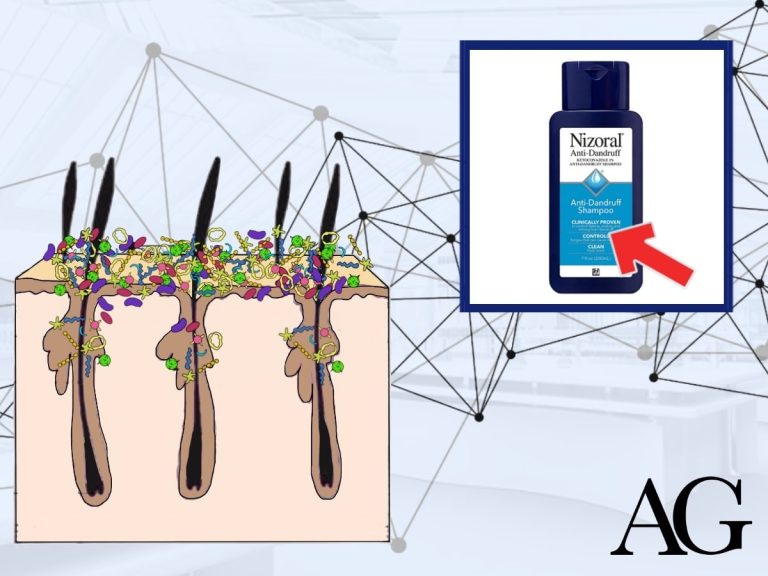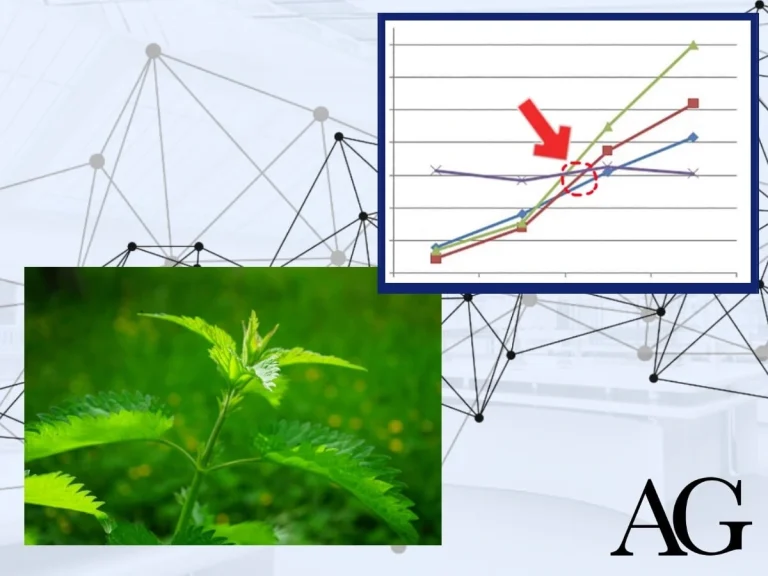In 1986, a 78 year old man in the United Kingdom with male pattern baldness was dozing in his armchair when he fell head first into a coal fire. Uh oh, thats gotta hurt!
This man sustained full thickness burns in the scalp (specifically in the left parietotemporal region, the bridge of the nose, and the left infraorbital area). Seeing as this was a tough Englishman, he refused hospital admission and surgery – so he was let go from the hospital1.
As little as 2 weeks later, this man commented that his bald patch had started to grow hair again. Over the next four months his hair continued to grow.


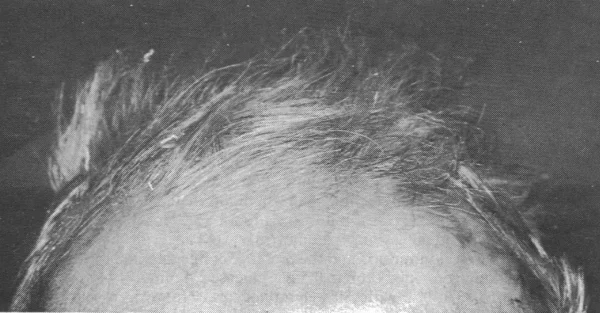
It is clear that prior to the burn, this man had experienced significant hair follicle miniaturisation. Interestingly, burning the cr*p out of his scalp reversed his hair loss fairly substantially.
It turns out out that this man is one of many people who have experienced unexpected hair growth as a result of an accidental wound. For example, a 25-year old Chinese man scolded his left cheek with boiling water. 8 months after the burn, he noticed hair growth around the wounded cheek.

There are other case studies of abrasions and wounds leading to hair growth. These case studies demonstrate that substantial hair loss reversal is possible even in people who have been balding for decades.
This article explores why certain wounds are triggering hair growth in some people and how you can safely recreate this wound-based hair growth response in a controlled way to help you restore thinning hair.
Prefer the video version? Check out the video below.
How do wounds regrow hair?
Reduced fibrotic tissue
The hormone dihydrotestosterone (DHT) plays a key role in hair follicle miniaturisation. DHT is elevated in balding scalps.
Studies also show that a signalling protein called TGF-β1 (Transforming growth factor beta 1) increases in areas of elevated DHT. Why does this matter? TGF-β1 has been shown to develop fibrotic tissue (scar tissue).
Researches have now known for years that scar tissue predictably develops around the hair follicles alongside the progression of baldness.

In other words, bald scalps are more than likely to have abundant scar tissue.
Some studies show that the onset of fibrosis is an adaptive response to reduce chronic inflammation (balding scalps tend to have chronic low-grade inflammation). In late stages of AGA, when the scalp is almost completely fibrotic, inflammation is lower. The amount of fibrotic tissue in the scalp has been found to be inversely proportional to inflammation. Fibrosis helps resolve scalp inflammation at the expense of hair.
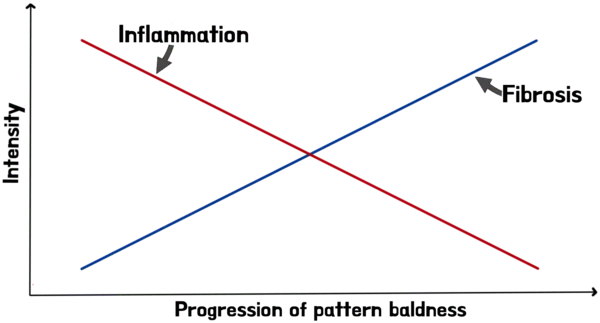
Okay, so balding scalps have fibrotic tissue, so what?
As fibrosis develops in the scalp, it restricts blood flow to the hair follicle, starving the hair follicle from the oxygen and nutrients its desperately needs.
Another major issue with perifollicular fibrosis is that as it develops, it progressively reduces the space available for the hair to grow in.
The problem with scar tissue, is that it is difficult to reduce and/or eliminate. This is why the removal of DHT from the scalp via a 5α-reductase inhibitor (e.g. finasteride or dutasteride) tends to stop further hair follicle miniaturisation but struggles to achieve much hair thickening. In order to achieve substantial hair re-growth, we would have to remove the fibrotic tissue that has already set in the scalp.
In response to some wounds, the body’s natural healing response can remodel scarred tissue by breaking down fibrotic tissue and replacing it with perfectly aligned cross-hatchings of new collagen, therefore expanding the space available for hair follicles and allowing them to become thicker in subsequent cycles.
The body achieves this by down-regulating scarring proteins like TGF-β1 and up-regulating scarless proteins like TGF-β3.
It’s worth mentioning that the body will respond differently to wounds of different severities. For instance, a stabbing wound is so severe that it will likely result in a big scar, rather than less scarring.
Improved blood supply
Blood is the carrier vehicle for oxygen and various nutrients that our cells depend on for healthy growth. Balding scalps have been shown time and time again to have reduced blood flow and oxygenation.
This study showed that balding scalps are considerably less oxygenated and this study showed that blood flow is 2.6 times lower in balding scalps.
After wounding, the natural healing mechanisms produces new blood vessels to help revascularise the injured region. This is known as angiogenesis.
An increase in VEGF (vascular endothelial growth factor) as a response to wounding can allow the area to revascularise and improve hair growth. A study investigating the role of VEGF in hair growth mentions that “These results identify VEGF as a major mediator of hair follicle growth and cycling and provide the first direct evidence that improved follicle vascularisation promotes hair growth and increases hair follicle and hair size.”
Increase in Wnt signalling
A deep-dive into the Wnt pathway would require an entire article dedicated to it. The high level summary is this: The Wnt pathway is a network of proteins involving the transmission of signals from outside the cell to the inside through cell surface receptors, leading to various cellular responses.
The Wnt pathway is the crux of hair growth. It’s essential for activation of the biological pathways that regulate the cell cycle and in turn the hair cycle.
There are several Wnt signalling pathways. They all contribute to hair growth in some way.

This study mentions that “Wnt signalling is activated by wounding and participates in every subsequent stage of the healing process”.
This is corroborated by a mice study that found that when “Wnt signaling is abrogated [avoided] in dermal fibroblasts, resulting in decreased hair neogenesis [regeneration]”.
Wound-based hair growth modalities
Burning your scalp with hot coals in an attempt to grow hair can backfire. You can try this at home, but I don’t suggest it! There are safe wound-based hair growth modalities that can induce temporary acute inflammation which then triggers the body to grow hair. Some of these therapies include microneedling and scalp massages.
These hair growth protocols follow the principle of ‘what doesn’t kill you makes you stronger’.
Microneedling
Microneedling involves creating micro-channels along balding areas of the scalp. You can use either a ‘derma roller’ or a ‘derma pen’. A derma roller is a device with multiple tiny needles nested into a drum-like cylinder which can then be rolled over the skin. A ‘derma pen’ is a pen-like device that is held vertically over the skin. The pen then vibrates a number of needles up and down, creating micro-channels in the skin.
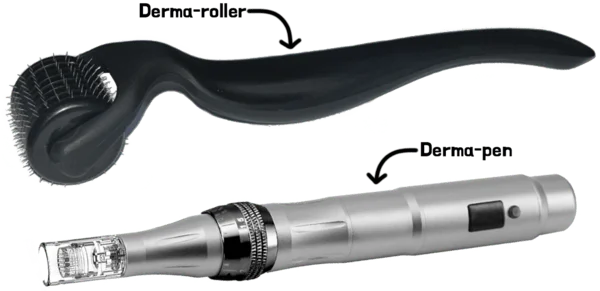
If you choose to try out microneedling and opt for a derma roller over a derma pen, its best to look out for rollers with individual needles. Knock-off derma-rollers contain serrated disks that are closer to little triangular daggers instead of needles.
These impostor derma rollers have wider bases and therefore create slashing and scraping wounds which have been known to leave traction marks on the skin.
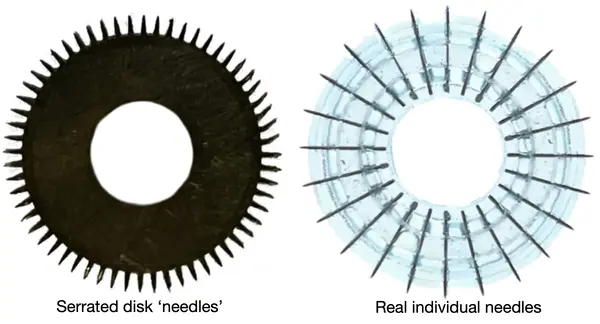
On the other hand, legitimate devices using individual needles create gentle and uniform punctures that trigger wound healing responses without causing notable harm.
Scalp massages
By scalp ‘massages’, I’m referring to a vigorous form of physical scalp stimulation which may be better described as a scalp ‘workout’ rather than a ‘massage’.
A case study of a 70-year old man that experienced ‘almost complete restoration of his hair’ after 20 weeks of twice daily 3 minute scalp massages. Another study resulted in hair thickness increase after 24 weeks of 4 minutes of scalp massages per day.
If you’d like to read a FREE hair loss e-book (and start making great hair loss improvements), get you copy here.

